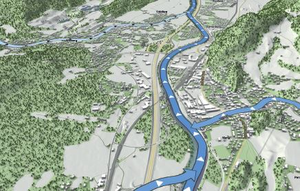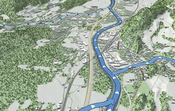Information
- Publication Type: PhD-Thesis
- Workgroup(s)/Project(s):
- Date: January 2020
- TU Wien Library:
- Open Access: yes
- 1st Reviewer: Natalie Andrienko
- 2nd Reviewer: Elmar Eisemann
- Rigorosum: January 2020
- First Supervisor: Eduard Gröller

- Pages: 167
- Keywords: Interactive visualization, uncertainty, flood management, decision support, flood simulation
Abstract
Floods are catastrophic events that claim thousands of human lives every year. For theprediction of these events, interactive decision support systems with integrated floodsimulation have become a vital tool. Recent technological advances made it possibleto simulate flooding scenarios of unprecedented scale and resolution, resulting in verylarge time-dependent data. The amount of simulation data is further amplified by theuse of ensemble simulations to make predictions more robust, yielding high-dimensionaland uncertain data far too large for manual exploration. New strategies are thereforeneeded to filter these data and to display only the most important information to supportdomain experts in their daily work. This includes the communication of results to decisionmakers, emergency services, stakeholders, and the general public. A modern decisionsupport system has to be able to provide visual results that are useful for domain experts,but also comprehensible for larger audiences. Furthermore, for an efficient workflow, theentire process of simulation, analysis, and visualization has to happen in an interactivefashion, putting serious time constraints on the system.In this thesis, we present novel visualization techniques for time-dependent and uncertainflood, logistics, and pedestrian simulation data for an interactive decision support system.As the heterogeneous tasks in flood management require very diverse visualizations fordifferent target audiences, we provide solutions to key tasks in the form of task-specificand user-specific visualizations. This allows the user to show or hide detailed informationon demand to obtain comprehensible and aesthetic visualizations to support the task athand. In order to identify the impact of flooding incidents on a building of interest, onlya small subset of all available data is relevant, which is why we propose a solution toisolate this information from the massive simulation data. To communicate the inherentuncertainty of resulting predictions of damages and hazards, we introduce a consistentstyle for visualizing the uncertainty within the geospatial context. Instead of directlyshowing simulation data in a time-dependent manner, we propose the use of bidirectionalflow maps with multiple components as a simplified representation of arbitrary materialflows. For the communication of flood risks in a comprehensible way, however, thedirect visualization of simulation data over time can be desired. Apart from the obviouschallenges of the complex simulation data, the discrete nature of the data introducesadditional problems for the realistic visualization of water surfaces, for which we proposerobust solutions suitable for real-time applications. All of our findings have been acquiredthrough a continuous collaboration with domain experts from several flood-related fieldsof work. The thorough evaluation of our work by these experts confirms the relevanceand usefulness of our presented solutions.
Additional Files and Images
Additional images and videos
Additional files
Weblinks
BibTeX
@phdthesis{Cornel_2020,
title = "Interactive Visualization of Simulation Data for
GeospatialDecision Support",
author = "Daniel Cornel",
year = "2020",
abstract = "Floods are catastrophic events that claim thousands of human
lives every year. For theprediction of these events,
interactive decision support systems with integrated
floodsimulation have become a vital tool. Recent
technological advances made it possibleto simulate flooding
scenarios of unprecedented scale and resolution, resulting
in verylarge time-dependent data. The amount of simulation
data is further amplified by theuse of ensemble simulations
to make predictions more robust, yielding
high-dimensionaland uncertain data far too large for manual
exploration. New strategies are thereforeneeded to filter
these data and to display only the most important
information to supportdomain experts in their daily work.
This includes the communication of results to
decisionmakers, emergency services, stakeholders, and the
general public. A modern decisionsupport system has to be
able to provide visual results that are useful for domain
experts,but also comprehensible for larger audiences.
Furthermore, for an efficient workflow, theentire process of
simulation, analysis, and visualization has to happen in an
interactivefashion, putting serious time constraints on the
system.In this thesis, we present novel visualization
techniques for time-dependent and uncertainflood, logistics,
and pedestrian simulation data for an interactive decision
support system.As the heterogeneous tasks in flood
management require very diverse visualizations fordifferent
target audiences, we provide solutions to key tasks in the
form of task-specificand user-specific visualizations. This
allows the user to show or hide detailed informationon
demand to obtain comprehensible and aesthetic visualizations
to support the task athand. In order to identify the impact
of flooding incidents on a building of interest, onlya small
subset of all available data is relevant, which is why we
propose a solution toisolate this information from the
massive simulation data. To communicate the
inherentuncertainty of resulting predictions of damages and
hazards, we introduce a consistentstyle for visualizing the
uncertainty within the geospatial context. Instead of
directlyshowing simulation data in a time-dependent manner,
we propose the use of bidirectionalflow maps with multiple
components as a simplified representation of arbitrary
materialflows. For the communication of flood risks in a
comprehensible way, however, thedirect visualization of
simulation data over time can be desired. Apart from the
obviouschallenges of the complex simulation data, the
discrete nature of the data introducesadditional problems
for the realistic visualization of water surfaces, for which
we proposerobust solutions suitable for real-time
applications. All of our findings have been acquiredthrough
a continuous collaboration with domain experts from several
flood-related fieldsof work. The thorough evaluation of our
work by these experts confirms the relevanceand usefulness
of our presented solutions. ",
month = jan,
pages = "167",
address = "Favoritenstrasse 9-11/E193-02, A-1040 Vienna, Austria",
school = "Research Unit of Computer Graphics, Institute of Visual
Computing and Human-Centered Technology, Faculty of
Informatics, TU Wien ",
keywords = "Interactive visualization, uncertainty, flood management,
decision support, flood simulation",
URL = "https://www.cg.tuwien.ac.at/research/publications/2020/Cornel_2020/",
}


 image
image PhD Thesis
PhD Thesis
